Table of Contents
About Catatonic Schizophrenia
Catatonic schizophrenia is a rare form of schizophrenia that is characterized by a person being in a state of stupor. This means that the person is unresponsive and inactive, and they may be in a trance-like state. People with catatonic schizophrenia may also exhibit extreme movement disorders, such as rigidity, posturing, and catatonia.
Catatonic schizophrenia is a form of schizophrenia that is characterized by a severe decrease in movement. This can manifest itself as a complete lack of movement, rigid muscles, and a general stiffness in the body. Catatonic schizophrenia can also cause the person to become very still and silent, even when in the company of others.
People who are affected by catatonic schizophrenia may also experience symptoms such as delusions and hallucinations. These symptoms can be very distressing and can cause the person to act in ways that are completely out of character.
There is no known cure for catatonic schizophrenia, but there are treatments that can help to manage the symptoms. These treatments may include medication, therapy, and support from family and friends. With the right treatment and support, many people with catatonic schizophrenia are able to lead relatively normal lives.

Facts Regarding Catatonic Schizophrenia
Catatonic schizophrenia is a subtype of schizophrenia that is characterized by disturbances in motor behavior. This can include excessive movement, rigid muscles, and a lack of movement. Catatonic schizophrenia can also include symptoms of schizophrenia such as delusions and hallucinations.
Catatonic schizophrenia is a rare and severe form of schizophrenia. It is characterized by a severe disruption in normal thinking and behavior, as well as by delusions and hallucinations.
People with catatonic schizophrenia may exhibit a wide range of symptoms, including sudden and unexpected changes in behavior, extreme apathy, complete withdrawal from social interaction, and excessive motor activity. They may also exhibit rigid body movements, repetitive movements, and abnormal postures.
People with catatonic schizophrenia often find it difficult to care for themselves and may require hospitalization for extended periods of time. There is no known cure for catatonic schizophrenia, but with proper treatment, many people with the condition can lead relatively normal lives.
Symptoms of Catatonic Schizophrenia
Catatonic schizophrenia is a subtype of schizophrenia that is characterized by a combination of symptoms that may include catatonia, which is a state of stupor or extreme immobility. Other symptoms may include disorganized thinking, delusions, and hallucinations.
Catatonic schizophrenia is a rare type of schizophrenia that is characterized by a severe disruption in normal movement. People with catatonic schizophrenia may move very little or may move constantly in a repetitive or purposeless way. They may also be unresponsive to others, even when spoken to directly.
In addition to movement problems, people with catatonic schizophrenia may also experience symptoms such as delusions, hallucinations, and problems with thinking and understanding. The cause of catatonic schizophrenia is unknown, but it is thought to be related to problems with the brain’s function. There is no cure for catatonic schizophrenia, but treatment with medications and therapy can help reduce symptoms.
Risk of Catatonic Schizophrenia
Catatonic schizophrenia is a rare and severe form of schizophrenia that is characterized by a combination of symptoms that can include catatonia a state of extreme physical and psychological stillness. People with catatonic schizophrenia may be unresponsive to others, remain in the same position for long periods of time, or repeat the same actions over and over again.
Risk of catatonic schizophrenia is high in individuals who have a family history of the disorder, are male, and are under the age of 25. The disorder is caused by a combination of environmental and genetic factors. The environmental factors may include exposure to viruses or other infections, head injury, and extreme stress. The genetic factors may include abnormalities in certain genes that control the way the brain works.
Catatonic schizophrenia is a rare form of the disorder that causes a person to become motionless and mute. This form of the disorder occurs in about 1 percent of people with schizophrenia. The risk of catatonic schizophrenia is highest in people who have a family history of the disorder. Males are also more likely to develop catatonic schizophrenia than females. The risk is also higher in people who are younger than 25 years old.
There is no cure for schizophrenia. However, the disorder can be treated with medications and therapy. The goal of treatment is to reduce the symptoms of the disorder and help the person to live a normal life.
Diagnosis of Catatonic Schizophrenia
Catatonic schizophrenia is a mental disorder that is characterized by disturbances in movement. People with catatonic schizophrenia may become motionless for long periods of time, or they may move in an agitated or purposeless way. They may also exhibit peculiar facial expressions or speak in a strange or robotic way.
There is no one-size-fits-all answer to the question of how to diagnose catatonic schizophrenia, as the condition can manifest in a variety of ways. In general, however, doctors will look for certain key symptoms when making a diagnosis, including:
- Stupor or extreme lethargy
- Excessive motor activity or agitation
- Inability to speak or respond to questions
- Immobility or extreme resistance to movement
- Grimacing, staring, or other peculiar facial expressions
- Repeated, inappropriate movements or gestures
If a person displays at least two of these symptoms for a significant period of time, doctors will typically consider a diagnosis of catatonic schizophrenia.






